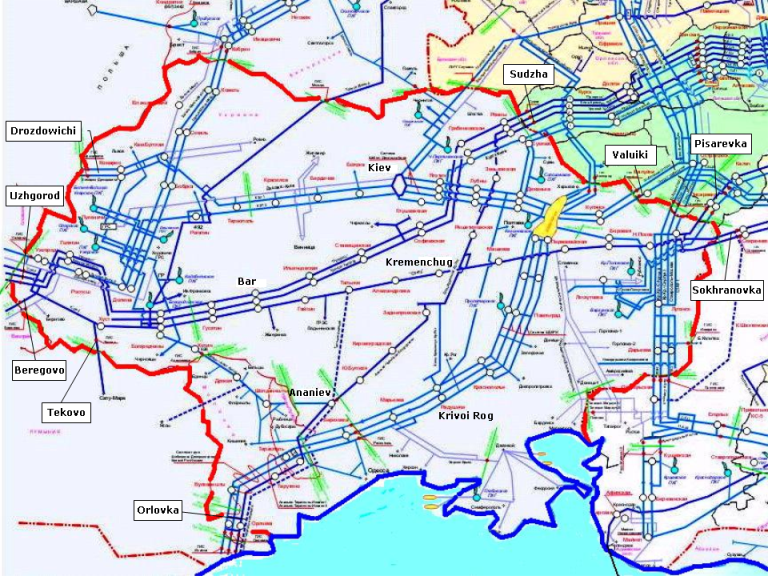|
Gazprom
insists on using
just one specific pipeline
Gas
transmission system (GTS) of Ukraine is a sophisticated technological object
and an integrated part of the Unified Gas Supply System (UGSS) of the former
USSR. The UGSS was build as a complex mechanism for synchronized operation
of gas production, transmission, storage and distribution activities. In the
1970s and 1980s, the Ukrainian part of the UGSS was developed and expanded
into a huge terminal for exports of large volumes of Russian gas to Europe.
After the division of the UGSS, the gas supply systems of Russia and Ukraine
continued their synchronous and coordinated work until the first partial
cutoff of 2006 and the total cutoff of January 2009.
Technical Scheme of Ukrainian Gas Pipelines

Source:
Gazprom
Until this
January, Russia was supplying to the GTS of Ukraine up to 185 bcm/year
of gas, including some 120 bcm/year of gas for exports to Europe,
Turkey and Moldova. In 1999-2008, the daily flow of gas to Ukraine was
fluctuating from 400 to 570 million cubic meters (mmcm).
Daily export flows to Europe were up to 400 mmcm. In 2003-2008, daily
exports have never been below 235 mmcm.
GTS of
Ukraine, same as the GTS of Russia, is not just a set of separate pipelines
running from point A to point B. Any large-scale GTS is an integrated
network of pipelines and extensions with interconnectors and laterals, that
are designed to provide additional security of supply in case of pipeline
failure.
Table 1.
Export and Import Gas Pipelines of Ukraine
|
Pipeline |
Capacity, |
Number |
|
Name (import-export gas
metering station) |
bcm/yr |
of lines |
|
Orenburg-Western border
(Sokhranovka-Uzhgorod) |
26 |
1 |
|
Urengoy-Uzhgorod
(Sudzha-Uzhgorod) |
28 |
1 |
|
Yamburg-Western
border (Sudzha-Uzhgorod) |
28 |
1 |
|
Dolina-Uzhgorod (Uzhgorod) |
20 |
2 |
|
Komarno-Drozdowichi (Drozdowichi) |
5 |
2 |
|
Uzhgorod-Beregovo
(Beregovo) |
11 |
2 |
|
Hust-Satu
Mare (Tekovo) |
2 |
1 |
|
Ananiev-Tiraspol-Izmail
(Orlovka) |
24 |
1 |
|
Shebelinka-Krivoi Rog-Izmail (Orlovka) |
24 |
3-2 |
|
Total export capacity: |
143 |
|
|
Major
import pipelines: |
|
|
|
Yelets-Kremenchug-Krivoi Rog
(Sudzha) |
31 |
1 |
|
Yelets-Kursk-Dikan'ka (Sudzha) |
15 |
1 |
|
Kursk-Kiev (Sudzha) |
14 |
1 |
|
Ostrogozhsk-Shebelinka
(Valuiki) |
23 |
2 |
|
Urengoy-Novopskov
(Pisarevka) |
31 |
1 |
|
Petrovsk-Novopskov
(Pisarevka) |
14 |
1 |
|
Orenburg-Novopskov (Sokhranovka) |
18 |
1 |
Note:
Click here for a scheme of export pipelines of
Western Ukraine.
Table 1 shows
annual capacity of all export pipelines and major import pipelines of
Ukraine (excluding these running from Belarus). Please note that the transit
pipelines Urengoy-Uzhgorod< Yamburg-Western border and Orenburg Western
border are also importing gas to the Ukrainian territory.
The Balkan
pipeline receives gas from two trunklines: Ananiev-Tiraspol-Izmail (one
line) and Shebelinka-Krivoi Rog-Izmail (two lines at Orlovka). To the
Ananiev compressor station, gas is delivered by the Yelets-Kremenchug-Krovoi
Rog (YKKR or ЕККР in Russian) and the Kremenchug-Ananiev
pipeline. The named pipeline routes of Southern Ukraine deliver gas both to
the domestic consumers and for exports.
Synchronous operation of all the lines is required to fill the Balkan
pipeline in winter period.
Since
Jan-13, Gazprom is trying to supply gas only to the Yelets-Kremenchug-Krivoi
Rog (YKKR) pipeline,
the least convenient line for shipping gas to Europe now.
The YKKR route is being used to supply gas to the
consumers of Eastern and Southern Ukraine. It is
not possible to use this line for exporting 76.6 mmcm/day without cutting
off deliveries to the domestic market. After the
supplies of gas from Russia to Ukraine were cut on Jan-1, Ukrtransgaz had to
change to flow pattern of Ukrainian gas produced in Shebelinka, Eastern
Ukraine.
If gas
from teh Russian side is supplied only to the YKKR pipeline, it is not
possible to evacuate it
to Orlovka
or Uzhgorod. It does not make sense for
Ukraine to take the gas into the pipeline system because it would cause new
accusations of theft, which in turn would complicate the situation.
From
the technical
point of view, gas transmission systems of Russia and Ukraine are
still integrated, even having the gas metering stations at the
border. A reliable transit of gas, as it
was during the most of the post-Soviet history, can be provided only
by the synchronized and coordinated operations of both parties. The
integrated system of pipelines, underground storage facilities and
distribution stations of Ukraine can operate only under the
balanced supplies of gas to all import terminals.
The lack of flexibility in the position of
Gazprom and unwillingness to consider other options is
counterproductive.
Mikhail
Korchemkin
January 16, 2009
PS.
Russian state TV
contradicts the press-releases of Gazprom
On
January 13, Gazprom published a statement on
the restoration of transit flow of 76.6 mmcm from Sudzha to Orlovka
and Moldova. Note that Gazprom's request to ship 22.2 mmcm from
Sudzha to Uzhgorod
has
been routinely rejected by Naftogaz.
The
same day, major Russian news program
"Vremya"
showed news clips from the Central Dispatching Office of Gazprom,
Suzhda and Uzhgorod. The viewers could clearly see that Gazprom
has opened the valve at the Yelets-Kremenchug-Krivoi Rog (YKKR)
pipeline, but the journalists somehow expected to see the gas flow
coming out in Uzhgorod.
It
was also clear that both the Urengoy-Uzhgorod and Yamburg-Uzhgorod
pipeline stayed empty.
Reproduction or use of the materials is allowed only with the reference to East European Gas
Analysis or www.eegas.com
|